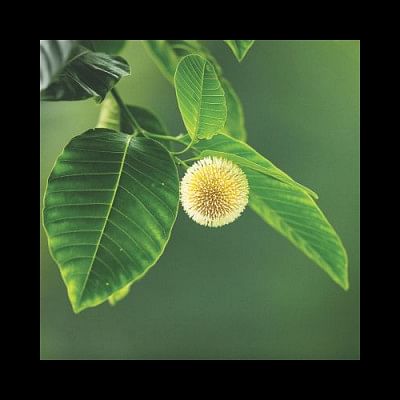Kadam

Kadam (Neolamarckia cadamba, burflower tree) is a common tree in Bangladesh. It arrives during the rainy months and continues to bloom throughout the season. This year it arrived prematurely, perhaps accelerated by the early rains.
I am especially fond of the kadam trees in Baridhara Park adjacent to the lake. They are mature evergreen trees, tall and erect, with neat, well-trimmed branches growing horizontally from the trunk. The leaves, perhaps six inches long, are thick and dark green. Whenever I walk or run near them, I feel the comfort and darkness of rain pouring from the sky, even in the driest of seasons. Together with the other tall trees of the park, they create a bucolic environment in this small corner of our busy city.
The kadam flowers profusely. The round, golf-ball sized flowers are coloured somewhere between yellow and orange, and all around the surface of this dense pollen-covered ball protrude numerous short white filaments. This year, for the first time in my life, I held the flower in my hands. The soft texture of the white filaments caressed my palm, like a child's fuzzy ball. Its sweet fragrance surprised my nostrils.
The beauty of the flowers degrades rapidly after blooming. In the kadam trees in Baridhara Park, for example, I was able to photograph unblemished flowers only the first two days of the bloom. After that, the white filaments started dropping and dark marks appeared on the yellow-orange balls like ugly blemishes on a beautiful face. This was the beginning of the ripening process. The outer layer of the flowers eventually decomposed and peeled off, leaving a bright-green, firm, round seed, smaller than the original flower.
When a kadam flower starts to ripen, it emanates a mild but disagreeable odour. This is the smell that most people associate with it. However, the fragrance of the freshly-bloomed flower is sweeter as I discovered.
The fragrance attracts many insects including bees which converge on the flower and help with pollination. Later, as the kadam ripens, the birds come to feast on it. Among these are bulbuls and the black-hooded oriole which peck at the flower making a delightful mess, like an infant eating porridge for the first time.
There appears to be controversy over its scientific name, Neolamarckia cadamba because the kadam tree is also called Anthocephalus cephalus. Further, the great Scottish botanist William Roxburgh named it Nauclea cadamba. Today most references use the first two names synonymously. The origin of the tree also appears controversial as some claim it came from Madagascar while others say it is Asian.
Kadam trees are relatively easy to grow in our climate and soil. They can reach heights of 150 feet with a strong, erect trunk, a broad, dense crown. Left untrimmed, its radial branches grow long and thick. The wood is not particularly strong and used for pulp, paper mills, plywood, boxes and crates.
The kadam has a large place in our culture and mythology. It is friendly to the environment. Various parts of the tree have medicinal uses. With the coming planting season it would be a good tree to consider planting in your land. It will give you years of pleasure while feeding many a bird and insect. Who knows, you might grow to like the odour of its ripe flowers!
www.facebook.com/tangents.ikabir

 For all latest news, follow The Daily Star's Google News channel.
For all latest news, follow The Daily Star's Google News channel. 



Comments